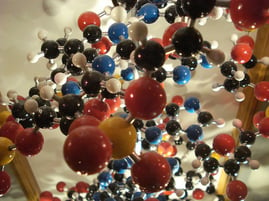
When doing biological applications in the laboratory, it is essential that you have your phosphate buffers available at all times. This is of extreme importance since most biological applications are very sensitive to changes in pH, and these buffers are very effective in keeping the pH range of cellular fluids within the normal range (6.9 to 7.4).
Since phosphoric acid has multiple dissociation constants, you can prepare phosphate buffers near pH 2.15, 6.86 and 12.32. However, most phosphate buffers are prepared at pH 7 using monosodium phosphate and its conjugate base, disodium phosphate.
Preparing Phosphate Buffers
In preparing phosphate buffers, you must know what molarity you want it to be, what volume to make and what the desired pH is. Most phosphate buffers are used at a concentration between 0.1M and 10M, while the pH should be kept within one pH unit from the pKa of the acid/conjugate base.
Using the Henderson-Hasselback equation below, calculate how much acid and base you need to come up with a buffer of the desired pH.
pH = pKa + log ([Base]/[Acid])
Use the required amounts of acid and base as derived from the equation and mix them in slightly less than one liter of water to prepare a rough buffer solution.
Check the pH using a pH meter and adjust it accordingly using phosphoric acid or sodium hydroxide. Add enough water to bring the total volume to 1 liter once you have reached the desired pH. You can now use this buffer as a stock solution, and dilute it to make up buffers at different concentrations.
Additional Tips for Preparing Phosphate Buffers
- Prepare buffers at the appropriate temperature. It is highly recommended that you prepare your buffers at the temperature at which you will be performing your experiments since changes in temperature may result in a shift in dissociation.
- Prepare buffers using the right concentration. Changes in concentration may likewise cause a shift in dissociation, so make pH adjustments after you have diluted the stock to the desired concentration and equilibrated it at the appropriate temperature. At the very least, make sure you check the pH after dilution.
- Use the pH meter correctly. To get accurate results, maintain your pH meters properly. Make sure the electrodes are clean and filled, and pH calibration buffers are correctly prepared and free of any contamination. Since the pH meter electrode is temperature-dependent, the meter should be set to ambient temperature while measuring the pH.
- Prepare buffers correctly and consistently. When creating instructions for buffer preparation, make sure you include the grades and sources of materials used, the acid or base used and the recommended concentration, and at what point during the preparation pH measurements were made. Make sure all the details of the procedure are clearly spelled out to prevent any confusion.
- Observe proper precautions. Wear protective clothing and eyewear, especially when working with acids and bases, and do not neutralize a strong acid with a strong base because this may generate an exothermic reaction that can melt the container you are using.
- Observe proper storage. Commercially prepared buffers should be stored in their original containers while basic buffers should not be stored in glass containers since the silicic materials will be attacked and will be eventually dissolved by the base. This can lead to etching of the glass and neutralization of the base.
- Avoid microbial contamination. Phosphate-containing buffers and buffers in the near-neutral pH range are susceptible to microbial contamination. You'll know the buffer is contaminated when the solution starts to look cloudy. To prevent this from happening, you should sterilize your buffers, manipulate them using sterile technique, and maintain stock solutions of sufficiently high ionic concentration (ideally at 0.5M). For analytical chemistry procedures, phosphate buffers in target concentration ranges (typically 0.1–0.5M) should be refrigerated and kept for no more than one week. Other buffers can be stored longer, but usually not more than two weeks.
Image source: allispossible






